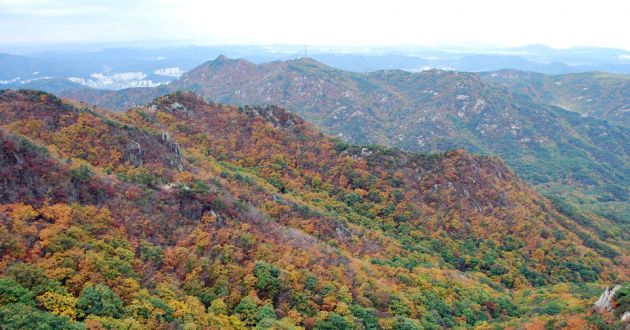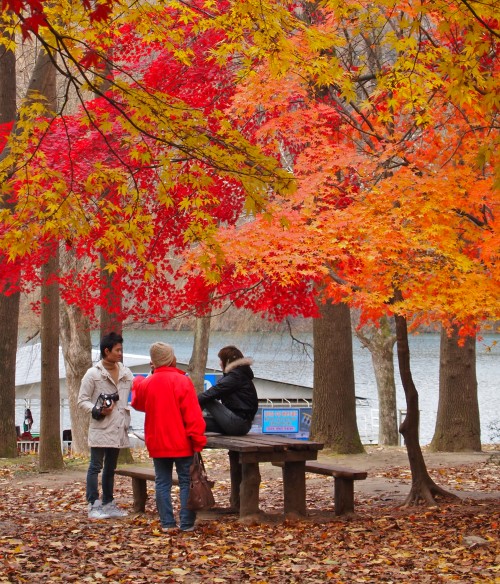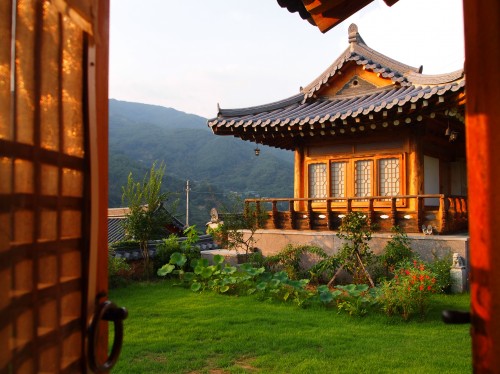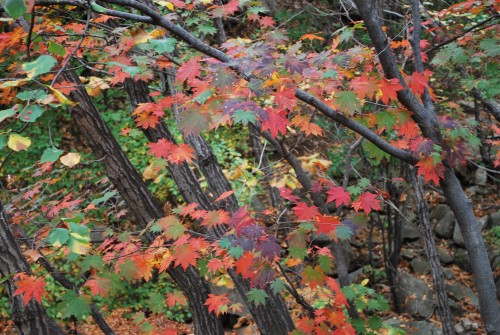The French existentialist and philosopher Albert Camus once said, “Autumn is a second spring when every leaf is a flower.”

That famous line reminds me why this is my favorite time of the year, and Korea is a great place to see autumn in all its colorful glory.
Korea’s climate has four distinct seasons, and fall is when the mild climate and limited rainfall make traveling especially comfortable.
The Korean word for autumn leaves is danpoong (단풍), … and come to think of it, it’s funny that English doesn’t have its own word, at least to my knowledge. Maybe the leaves here are just more spectacular?

Typically, mid-October into early November is peak time to see the leaves turn, and it’s probably no surprise that Korea’s many mountains are among the best places to see the forests in “bloom.”
Generally, the color first hits the nation’s northern areas and moves south quickly. Word has it that this autumn’s lack of rainfall might mean a slightly less spectacular show than usual, but I still strongly suggest you go.
Here is a quick look at the 4 best mountains for autumn color in Korea (IMHO):
Seoraksan (석악산)
Seoraksan mountain in Gangwon Province is undeniably Korea’s most famous destination for leaf viewing.

I visited Outer Seorak several weeks ago, and given how gorgeous it was during the summer, it’s got to be even more breathtaking this time of year. There are many paths that lend dramatic views of its craggy cliffs, including a 9-hour course that takes you between the best peaks.
If you take the 5-hour bus from Seoul, I’d suggest allocating at least 2 days for your Seoraksan trip.
And here’s another reason to stay at Seoraksan. Many of Korea’s popular hiking trails are located near natural hot springs. During a crisp autumn nightfall and after a long hike, why not take a refreshing mineral bath?
| Open: | Trails are generally open sunrise to sunset. |
| Admission Price: | Free |
| Address: | Gangwon Province Sokcho-si Seoraksan-ro |
| Directions: | From Sokcho bus terminal, take bus #7 or 7-1 to Seorak-dong (the final stop) |
| Phone: | 02-1330 |
| Website: | Official Site |
Jirisan (지리산)
Moving south, straddling the borders of South Gyeongsang, North Jeolla and South Jeolla Provinces is Jirisan mountain.

Jirisan is perhaps Korea’s most famous (and beloved) mountain. It is also the site of the nation’s first national park. For hikers, at 1,130 meters above sea level, it also boasts the highest altitude of all mountain paths in Korea, which, of course, means especially spectacular views.
Jirisan’s Piagol Valley is especially famous, even hosting an annual Crimson Leaves Festival. Jo Shik, a Confucian scholar of the Joseon Dynasty once said, “People who have not seen the red-tinted leaves in Piagol dare not say they know red-tinted leaves.”
Yes, sir! Consider combining your trip with a stop at nearby Hadong County (하동군).
| Open: | Trails are generally open sunrise to sunset. |
| Admission Price: | Free |
| Address: | South Jeolla Province Gurye-gun Masan-myeon Hwaeomsa-ro 356 |
| Directions: | From Seoul Nambu Terminal go to Gurye. From Gurye Bus Terminal take a bus for Seongsamjae and Nogodan. Get off at the Seongsamjae Parking Lot. |
| Phone: | 02-1330 |
| Website: | Official Site |
Naejangsan (내장산)
In terms of the calendar, if you’re running a bit late and the leaves are already turning up north, head south to Naejangsan mountain on the border of North and South Jeolla Provinces.

The Korean Meteorological Administration predicts peak color doesn’t typically occur until mid-November. And while you’re visiting Naejangsan, don’t miss the 200-meter long natural tunnel of yellow, orange and crimson leaves.
Other nearby attractions include Baegyangsa temple (배걍사), traditional folk villages and Confucian academies.
| Open: | Trails are generally open sunrise to sunset. |
| Admission Price: | Free |
| Address: | North Jeolla Province Jeongeup-si Naejang-dong |
| Directions: | From Seoul take an express bus to Jeongeup Bus Terminal. From there, take bus #171 to Naejangsan National Park |
| Phone: | 02-1330 |
| Website: | Official Site |
Gwanaksan (관악산)
A little closer to home or homebase (if that’s Seoul), the southern guardian mountain of Gwanaksan provides capital-area leaf lovers with a spectacular show each autumn.

Gwanaksan provides fairly easy climbs and can be reached via the efficient Seoul Metro subway system.
Like most Korean peaks, the mountain is home to several Buddhist temples, namely the Yeonjudae Hermitage (연주대), whose dramatic perch was designed to enable views of Gaeseong, now in North Korea.
| Open: | Typically sunrise to sunset |
| Admission Price: | Free |
| Address: | Seoul Gwanak-gu Sillim 9(gu)-dong |
| Directions: | Seoul National University Station (#228) on Line 2, Exit 3 |
| Phone: | 02-880-3684 |
| Website: | Official Site |
Before you go…
Before you go, a word of caution.
We’ve talked before on the show about the incredible popularity of hiking in Korea, so if you can plan your trip during the weekdays, I highly advise it.
But if work obligations leave only the weekends, be sure to arrive as early as possible. Most parks open at least one hour before sunrise.
About Matt Kelley
Matt Kelly is native of the US Pacific Northwest and is half-Korean by ethnicity. He lived in Korea for five years and has written hundreds of travel guides for Wallpaper, TimeOut, the Boston Globe and Seoul Magazine and was a host for several different variety shows on Korean radio and television.
